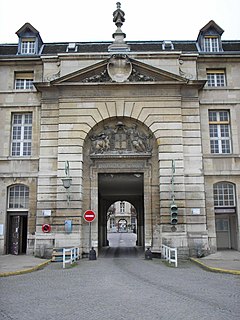
The Place de la Concorde is one of the major public squares in Paris, France Measuring 7.6 hectares in area, it is the largest square in the French capital. It is located in the city's eighth arrondissement, at the eastern end of the Champs-Élysées. It was the site of many notable public executions during the French Revolution.

The Place des Vosges, originally Place Royale, is the oldest planned square in Paris, France. It is located in the Marais district, and it straddles the dividing-line between the 3rd and 4th arrondissements of Paris. It was a fashionable and expensive square to live in during the 17th and 18th centuries, and one of the central reasons of the fashionable nature of Le Marais for the Parisian nobility.
The year 1800 in science and technology included many significant events.

Place Vendôme is a square in the 1st arrondissement of Paris, France, located to the north of the Tuileries Gardens and east of the Église de la Madeleine. It is the starting point of the rue de la Paix. Its regular architecture by Jules Hardouin-Mansart and pedimented screens canted across the corners give the rectangular place Vendôme the aspect of an octagon. The original Vendôme Column at the centre of the square was erected by Napoleon I to commemorate the Battle of Austerlitz; it was torn down on 16 May 1871, by decree of the Paris Commune, but subsequently re-erected and remains a prominent feature on the square today.

The Hôpital universitaire Pitié-Salpêtrière is a teaching hospital in the 13th arrondissement of Paris. Part of the Assistance publique – Hôpitaux de Paris and a teaching hospital of Sorbonne University, it is one of Europe's largest hospitals.

Tony Robert-Fleury was a French painter, known primarily for historical scenes. He was also a prominent art teacher, with many famous artists among his students.

The Bicêtre Hospital is located in Le Kremlin-Bicêtre, which is a commune in the southern suburbs of Paris, France. It lies 4.5 km from the center of Paris. The Bicêtre Hospital was originally planned as a military hospital, with construction begun in 1634. With the help of Vincent de Paul, it was finally opened as an orphanage in 1642. It was incorporated into the Hôpital Général in 1656. In 1823, it was called the Hospice de la Vieillesse Hommes. In 1885, it was renamed the Hospice de Bicêtre.

Jean-Étienne Dominique Esquirol was a French psychiatrist.

Jean-Louis-Marc Alibert was a French dermatologist born in Villefranche-de-Rouergue, Aveyron. He was a pioneer of French dermatology.

Guillaume-Marie-André Ferrus was a French psychiatrist born in Château-Queyras, near Briançon, Hautes-Alpes.
The Illustre Théâtre was a French theatre company set up by Molière on 30 June 1643, and shut down less than two years later on his imprisonment in August 1645. However, it is notable for its impact on the history of the French theatre. It was succeeded by la Troupe de Molière.

The Institut Philippe-Pinel de Montréal is a psychiatric hospital located in Montreal, Quebec for individuals accused of crimes and found to be not criminally responsible due to mental disorder. It is located at 10905 Henri Bourassa Blvd. East in the borough of Rivière-des-Prairies–Pointe-aux-Trembles. It is the only institution of its kind in Canada.

Philippe François Pinel, known as Dumanoir was a French playwright and librettist.

The Parc de la Butte-du-Chapeau-Rouge formerly known as the Square de la Butte-du-Chapeau-Rouge, is a public park in the 19th arrondissement of Paris, which was created in 1939. It is an example of 1930s modernist park design, and contains a fountain and works of sculpture from the Exposition Internationale des Arts et Techniques dans la Vie Moderne (1937) held at the Trocadéro.

The French Socialist Party held a two-round presidential primary to select a candidate for the 2017 presidential election on 22 and 29 January 2017. It was the second open primary held by the center-left coalition, after the primary in 2011 in which François Hollande defeated Martine Aubry to become the Socialist nominee. Hollande went on to defeat incumbent Nicolas Sarkozy in the 2012 presidential election. However, because of his low approval rating, he announced that he would not seek re-election, becoming the first president of the Fifth Republic to decide not to run for a second term. The primary was contested by seven candidates, four from the Socialist Party and three representing other parties part of the left-wing electoral alliance.
Joseph D'Aquin was an early pioneer in the field of psychiatry.
The canton of La Guerche-de-Bretagne is an administrative division of the Ille-et-Vilaine department, in northwestern France. At the French canton reorganisation which came into effect in March 2015, it was expanded from 12 to 31 communes. Its seat is in La Guerche-de-Bretagne.
Germain Pinel was a French lutenist and composer.
The Radical Movement, whose complete name is Radical, Social and Liberal Movement is a social-liberal political party in France.



















